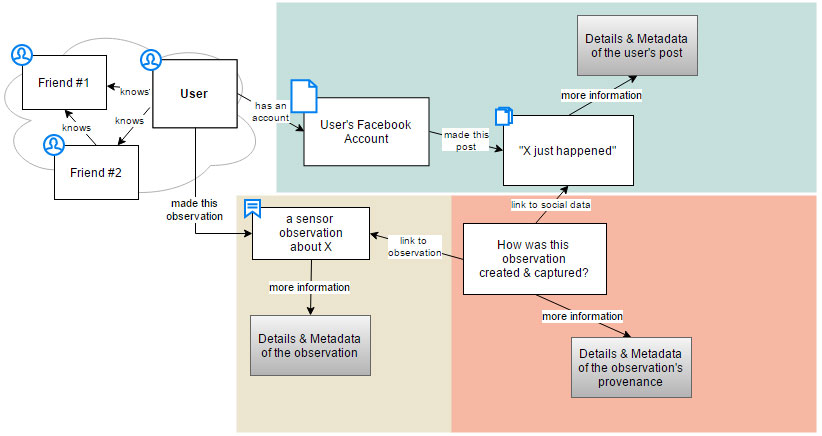The amount of content that Social Media users produce nowadays is staggering. As of the beginning of 2017, Facebook had 1.86 billion monthly active users [1], whereas Twitter averaged at 288 million. In such environments, humans act implicitly as sensors, making observations about real-world events or themselves that are extremely varied; from their opinion on what the weather is like, to what is happening out of their window, to how many miles they ran today in their daily workout routine.
In a way, these users can be treated as Social Sensors: a source of self-reported data that resembles sensor observations about a particular event or property and is accompanied by a wealth of social metadata, both very useful to a variety of scientific disciplines. Nevertheless, data from social sensors is mostly unstructured, untrusted and usually provided without the provenance chains that are required for assessing data quality and, eventually, decision making.
Semantic Web technologies can play a beneficial role in this emerging area. More specifically, ontologies, which are typically represented on the SW via OWL, the Web Ontology Language [2], clarify the domain’s structure of knowledge and enable knowledge-sharing [3]. The SOSENS framework is an ontology-based solution which provides a “semantic scaffold” for Social Sensing spaces. The basic ontology (SOSENS) leverages several well-known ontologies such as FOAF [4], SIOC [5] & SSN [6] (see Figure 1) to describe humans as Sensors on Social Media in a systematic manner. Extensions, in the forms of ontologies such as SOSENS-Trust, provide the groundwork for describing other aspects of Social Sensing spaces, such as Social Sensor data quality and trust.
Note: Hover over the image for a more detailed view

Figure 1: Describing a Social Sensor observation on Facebook using the Social Sensor (SOSENS) Ontology
All framework actions (adding a new sensor, adding a new sensor observation etc.) are further supported by the SOSENS API, which can help users construct rich semantic representations of their data, without necessarily knowing in-depth how the SOSENS family of ontologies is structured. Each SOSENS API endpoint has a simple and advanced usage mode, targeted to SW non-experts and experts respectively. To facilitate deployments by non-experts, a simple mode request sent to the API employs pre-determined ontologies to describe some of the common SSN building blocks, using either existing ontologies (such as the W3C’s TIME ontology) or ontologies custom-built for the SOSENS framework (such as the SOSENS Generic SSN Value ontology). Expert users can override these default choices and still take advantage of the JSON-style input to rapidly create SW data.
SOSENS is an ongoing project, currently in-development and this website will be updated accordingly to showcase its progress. You can see a working Web Demo of a SOSENS API call or contact the lead architect for more information.
Figure 2:Sample RDF - A Social Sensor observation
References
[1] “Facebook: monthly active users 2016,” Statista. [Online]
[2] “OWL Web Ontology Language Guide.” [Online]
[3] B. Chandrasekaran, J. R. Josephson, and V. R. Benjamins, “What are ontologies, and why do we need them?,” IEEE Intell. Syst., vol. 14, no. 1, pp. 20–26, 1999
[4] “FOAF - The Friend-of-a-friend ontology.” [Online]
[5] “SIOC Core Ontology Specification.” [Online]
[6] M. Compton, P. Barnaghi, L. Bermudez, R. G. Castro, O. Corcho, S. Cox, J. Graybeal, M. Hauswirth, C. Henson, and A. Herzog, “The SSN Ontology of the Semantic Sensor Networks Incubator Group,” J. Web Semant., 2011. [Online]